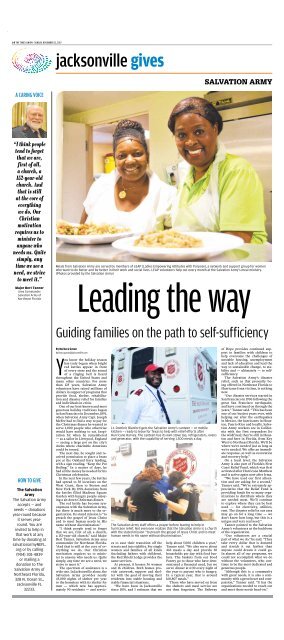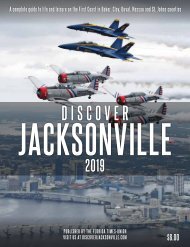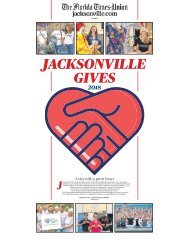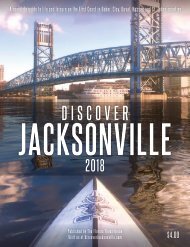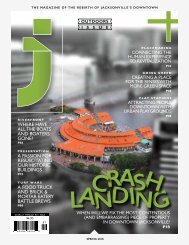Jax Gives 2017
Create successful ePaper yourself
Turn your PDF publications into a flip-book with our unique Google optimized e-Paper software.
J-8 THE TIMES-UNION · Sunday, November 12, <strong>2017</strong><br />
jacksonville gives<br />
SALVATION ARMY<br />
a caring voice<br />
“I think people<br />
tend to forget<br />
that we are,<br />
first of all,<br />
a church, a<br />
152-year-old<br />
church. And<br />
that is still<br />
at the core of<br />
everything<br />
we do. Our<br />
Christian<br />
motivation<br />
requires us to<br />
minister to<br />
anyone who<br />
needs us. Quite<br />
simply, any<br />
time we see a<br />
need, we strive<br />
to meet it.”<br />
Major Bert Tanner<br />
Area Commander<br />
Salvation Army of<br />
Northeast Florida<br />
Meals from Salvation Army are served by members of LEAP (Ladies Empowering Attitudes with Purpose), a network and support group for women<br />
who want to do better and be better in their work and social lives. LEAP volunteers help out every month at the Salvation Army’s meal ministry.<br />
(Photos provided by the Salvation Army)<br />
Leading the way<br />
Guiding families on the path to self-sufficiency<br />
how to give<br />
The Salvation<br />
Army<br />
The Salvation Army<br />
accepts — and<br />
needs — donations<br />
year-round because<br />
it serves yearround.<br />
You are<br />
invited to help in<br />
that work at any<br />
time by donating at<br />
salvationarmyNEFL.<br />
org or by calling<br />
(904) 301-4839<br />
or mailing a<br />
donation to The<br />
Salvation Army of<br />
Northeast Florida,<br />
328 N. Ocean St.,<br />
Jacksonville FL<br />
32233.<br />
By Barbara Gavan<br />
barbara.gavan@jacksonville.com<br />
Lt. Dominic Blanford gets the Salvation Army’s canteen — or mobile<br />
kitchen — ready to leave for Texas to help with relief efforts after<br />
Hurricane Harvey. The canteen has its own stove top, refrigerators, ovens<br />
and generator, with the capability of serving 1,500 meals a day.<br />
The Salvation Army staff offers a prayer before leaving to help in<br />
hurricane relief. Not everyone realizes that the Salvation Army is a church<br />
with the stated mission “to preach the gospel of Jesus Christ and to meet<br />
human needs in His name without discrimination.”<br />
You know the holiday season<br />
has truly begun when bright<br />
red kettles appear in front<br />
of every store and the sound<br />
of a ringing bell is heard<br />
throughout the United States and<br />
many other countries. For more<br />
than 125 years, Salvation Army<br />
volunteers have raised millions of<br />
dollars in support of programs that<br />
provide food, shelter, rehabilitation<br />
and disaster relief for families<br />
and individuals in crisis.<br />
One of our best-known and most<br />
generous holiday traditions began<br />
in San Francisco in December, 1891,<br />
when Salvation Army Capt. Joseph<br />
McFee had to find a way to pay for<br />
the Christmas dinner he wanted to<br />
serve 1,000 people who otherwise<br />
would have nothing to eat. Inspiration<br />
hit when he remembered<br />
— as a sailor in Liverpool, England<br />
— seeing a large pot on the city’s<br />
docks where charitable donations<br />
could be tossed.<br />
The next day, he sought and received<br />
permission to place a brass<br />
pot at the Oakland ferry landing,<br />
with a sign reading, “Keep the Pot<br />
Boiling.” In a matter of days, he<br />
had all the money he needed for his<br />
Christmas celebration.<br />
In the next few years, the kettles<br />
had spread to 30 locations on the<br />
West Coast, then to Boston and<br />
New York. By 1901, donations from<br />
the kettles filled Madison Square<br />
Garden with hungry people enjoying<br />
a sit-down Christmas dinner.<br />
The red kettle has become synonymous<br />
with the Salvation Army,<br />
but there is much more to the organization.<br />
Its stated mission is “to<br />
preach the gospel of Jesus Christ<br />
and to meet human needs in His<br />
name without discrimination.”<br />
“I think people tend to forget<br />
that we are, first of all, a church,<br />
a 152-year-old church,” said Major<br />
Bert Tanner, Salvation Army area<br />
commander for Northeast Florida.<br />
“And that is still at the core of everything<br />
we do. Our Christian<br />
motivation requires us to minister<br />
to anyone who needs us. Quite<br />
simply, any time we see a need, we<br />
strive to meet it.”<br />
The spectrum of assistance is a<br />
wide one. In Jacksonville alone, the<br />
Salvation Army provides nearly<br />
43,000 nights of shelter per year<br />
to the homeless with its shelter for<br />
men — which now has approximately<br />
90 residents — and services<br />
to ease their transition off the<br />
streets and into stability. For single<br />
women and families of all kinds<br />
(including fathers with children),<br />
the Red Shield Lodge provides the<br />
same services.<br />
At present, it houses 36 women<br />
and 16 children. Both homes provide<br />
casework, support and shelter<br />
with the goal of moving their<br />
residents into stable housing and<br />
stable financial situations.<br />
“We have been in Jacksonville<br />
since 1891, and I estimate that we<br />
help about 5,000 children a year,”<br />
Tanner said. “We also serve about<br />
463 meals a day and provide 50<br />
households per day with food baskets.<br />
The baskets from our Food<br />
Pantry go to those who have demonstrated<br />
a financial need, but we<br />
serve dinner at 6:30 every night of<br />
the year to anyone who is hungry.<br />
In a typical year, that is around<br />
168,807 meals.”<br />
Those who have moved on from<br />
the shelters and meal service are<br />
not then forgotten. The Pathway<br />
of Hope provides continued support<br />
to families with children to<br />
help overcome the challenges of<br />
unstable housing, unemployment<br />
and lack of education and lead the<br />
way to sustainable change, to stability<br />
and — ultimately — to selfsufficiency.<br />
The Salvation Army’s disaster<br />
relief, such as that presently being<br />
offered in Northeast Florida to<br />
Hurricane Irma victims, is nothing<br />
new.<br />
“Our disaster services started in<br />
San Francisco in 1906 following the<br />
great San Francisco earthquake,<br />
and have continued on through the<br />
years,” Tanner said. “This has been<br />
one of our busiest years ever, with<br />
helping out after the earthquakes<br />
in Mexico, the hurricanes in Houston,<br />
Puerto Rico and locally. Salvation<br />
Army workers are in California<br />
with the first responders [to<br />
the wildfires]; they’re still in Houston<br />
and here in Florida, from Key<br />
West to Northeast Florida. We’ll be<br />
where we’re needed just as long as<br />
we’re needed. We offer an immediate<br />
response, as well as restoration<br />
and recovery help.”<br />
On a local level, the Salvation<br />
Army is also part of Florida’s First<br />
Coast Relief Fund, which was first<br />
activated after Hurricane Matthew<br />
and is active again now after Irma.<br />
“We have used our first allocation<br />
and are asking for a second,”<br />
Tanner said. “We’re extremely appreciative<br />
that the Relief Fund is<br />
providing funds for so many organizations<br />
to distribute where they<br />
are needed most. We’ll continue<br />
to explore where they can be best<br />
used — for electricity, utilities,<br />
rent. The disaster relief in our area<br />
may go on for a long time — we<br />
don’t know how long, but this is a<br />
unique and very real need.”<br />
Tanner pointed to the Salvation<br />
Army’s volunteers as the backbone<br />
of the organization.<br />
“Our volunteers are a crucial<br />
part of what we do,” he said. “They<br />
take every dollar that is donated<br />
and stretch it out further than<br />
anyone could dream it could go.<br />
In almost all of our programs, we<br />
could not accomplish what we do<br />
without the volunteers, who continue<br />
to be the most dedicated and<br />
generous people.<br />
“Although this is a community<br />
with great needs, it is also a community<br />
with a great heart and compassion,”<br />
Tanner said. “It has the<br />
organizations needed to reach out<br />
and meet those needs head-on.”


